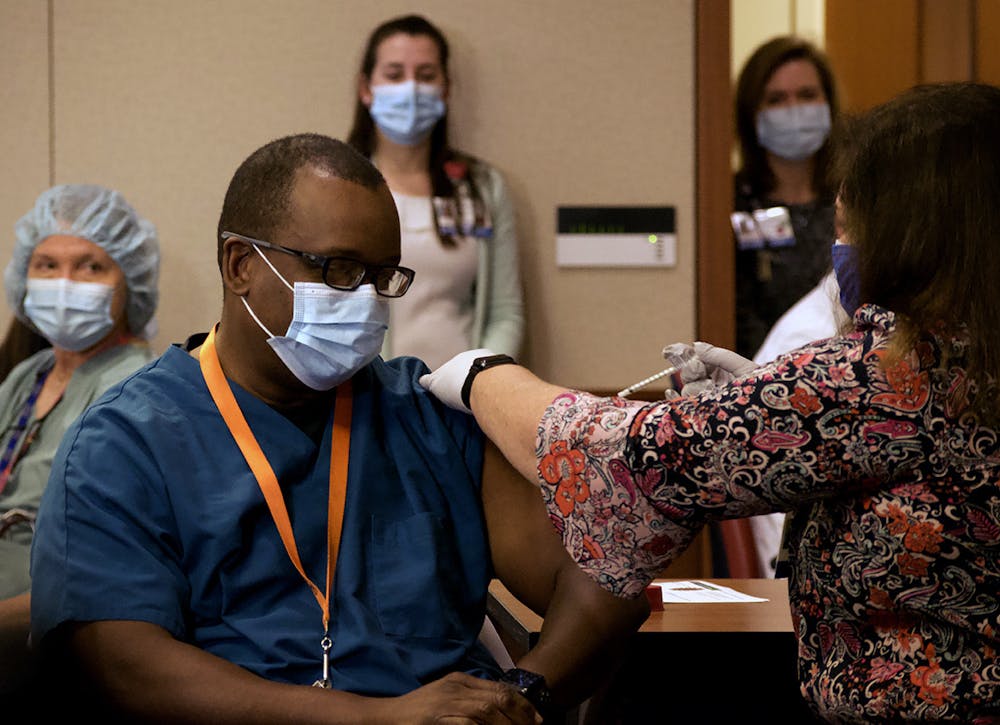A year after UF shut down on-campus activity because of COVID-19, students and residents are still dealing with the saliva tests, Zoom lectures and homemade cloth masks that disrupted daily life.
The start of 2020 signaled a growing threat to Gainesville residents when the U.S. confirmed its first COVID-19 case Jan. 20. Florida experienced its first two cases March 1, urging Gov. Ron DeSantis to declare a state of emergency shortly after. But while social distancing and mask-wearing persist, Alachua County is also feeling the added strain of more infectious variants and the cautious hope of approaching vaccines.
With downward trending cases and increasing vaccine availability, things are finally starting to look up in Alachua County. But it comes after months of watching the number of cases and death toll rise.
Here's how UF and Alachua County managed the first year of the COVID-19 pandemic:
Pandemic kindlings
The county’s first confirmed case stunted everyday activities March 10, 2020. Since then, 173,749 individuals have been tested with a 4.89% total positivity rate, according to the county’s recovery dashboard which pulls data from the Florida Department of Health. By March 16, all UF classes were pushed online.
When classes resumed in Fall, college-aged people flooded back to Gainesville and originally drove those numbers up due to asymptomatic spread, FDOH Administrator Paul Myers said.
The university faced its biggest spike in positive student cases with 217 added in one day on Sept. 13 –– about two weeks after the first day of Fall classes. UF administration tried to manage the uptick in positive cases, facing struggles with quarantine dorms, testing and faculty ADA accommodations.
Through contact tracing, the health department found restaurant and bar attendance by the younger population was most responsible for cases in the fall, Myers said.
When UF surpassed 5,000 total cases in late November, the response was to prepare for the future; starting in Spring, UF would mandate biweekly testing for UF-affiliates on campus.
Since about Feb. 26, the median age of positive cases has shifted from college-aged to people around 40 years old. Myers cited UF’s less than 1% positivity rate for on-campus testing as a sign that the university is in control of its population, and students are heeding public health advice. Meanwhile, the county’s positivity rate has ranged from 1% to 4.5% since the end of February.
Natural immunity from about 22,000 cumulative positive cases in the county coupled with more vaccinations should address disease consequences such as COVID-19 deaths in the elderly, Myers said. The county dashboard lists 12,018 residents who’ve received one dose and 39,365 who’ve gotten both doses as of Wednesday. There are about 269,043 total residents in Alachua county according to 2019 estimates by the U.S. Census Bureau.
Semester hurdles
Some of the county’s highest case tallies came days after major holidays, including Thanksgiving and Christmas. Jan. 8 alone brought 247 positive cases.
“That was really a perfect storm in terms of people getting together from different places inside,” Myers said.
In an attempt to avoid a similar fallout in the future, UF replaced 2021 Spring Break, which would’ve started March 8, with an extra week in Winter Break.
Reducing travel reduces spread, which reduces hospitalization, Myers said. Moving Spring Break from the middle of Spring semester to the beginning was an attempt to cut positive cases by limiting student travel, Myers added.
The move aimed to give students more time to recover if they tested positive for the virus or quarantine before coming back, Ken Garcia, a UF Health spokesperson, wrote in an email. He noted the university has seen its lowest number of on-campus cases since July 2020.
“This is good news and we must continue our efforts to prevent spread of the virus,” Garcia wrote.
Regardless of any downward trends, viral mutations were an inevitable and normal course of events, John Lednicky, a UF Health virologist, wrote in an email. Alachua County has confirmed seven positive cases of the mutation B.1.1.7 first detected in the U.K.
Mutations made the virus more infectious. He said it may lead to the need for additional immunizations to be developed in response.
The younger population is not invulnerable either, even if they feel the virus has no consequences on their health, he added.
“The bottom line is that the new variants may in fact be causing more severe illnesses in younger people now,” Lednicky wrote. “The illnesses may not be obvious at first but have long-term consequences.”
The possibility of brain fog, burning lungs, liver and kidney damage and other complications should be enough reason to continue social distancing guidelines, he wrote. Lingering issues are even present in virus strains.
A finale in sight
The county has had access to the Pfizer-BioNTech and Moderna COVID-19 vaccines and is awaiting shipments of the single shot Johnson & Johnson version, he said.
UF Health Shands Hospital has vaccinated less than half of its 11,000 Gainesville employees, Garcia wrote. The hospital’s collaboration with the FDOH has led to the immunization of about 42,500 people in Gainesville, Jacksonville and Central Florida.
Additionally, Myers said eligibility will expand Monday to ages 60 and up alongside DeSantis’ new executive order for individuals deemed “extremely vulnerable” by a physician. This includes K-12 school employees, law enforcement officers and firefighters 50 years and older.
And while current guidelines are still a must, the CDC put out its first recommendations for fully vaccinated people March 8. On that list of approved activities: indoor visits without masks or physical distancing for vaccinated and low risk unvaccinated individuals — indicating a return to normalcy.
Contact Manny Rea at mrea@alligator.org. Follow him on Twitter @ReaManny.

Manny Rea is a journalism sophomore and the current health reporter for The Alligator. He worked as a copy editor in his freshman year before moving over to the Avenue in summer 2020. He likes to listen to dollar-bin records and read comics, and he is patiently waiting to go back to movies and concerts.






